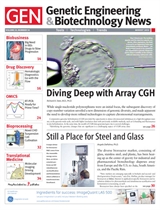Oct 10 2013
A close study of the genetic and metabolic causes of Lesch-Nyhan syndrome is yielding clues to the developmental and neuronal defects found in other, diverse neurological disorders such as Alzheimer's, Parkinson's, and Huntington's disease. This study encompasses gene expression defects specific to Lesch-Nyhan, a relatively rare disorder, as well as a range of related metabolic defects, which appear to work together to create all-too-familiar neuropathogenic patterns.
Lesch-Nyhan syndrome, an inherited neurodevelopmental disorder characterized by uncontrollable repetitive body movements, cognitive defects, and compulsive self-mutilating behaviors, is caused by defects in HPRT, a so-called housekeeping gene. The best recognized neural consequences of HPRT deficiency are defective basal ganglia expression of the neurotransmitter dopamine and aberrant dopamine neuronal function.
Hoping to delve deeper into the causes and consequences of HPRT deficiency, a team of scientists embarked on a gene expression study. The study, which appeared in PLOS ONE October 9, is entitled "The Housekeeping Gene Hypoxanthine Guanine Phosphoribosyltransferase (HPRT) Regulates Multiple Developmental and Metabolic Pathways of Murine Embryonic Stem Cell Neuronal Differentiation." It provides an experimental picture of how defects in the HPRT gene impair the ability of stem cells to produce normal neurons, resulting instead in neurological disease.
In addition, the study shows how HPRT deficiency dysregulates many cellular functions. Disturbed processes include cell cycle and proliferation mechanisms, RNA metabolism, DNA replication and repair, replication stress, lysosome function, membrane trafficking, the signaling pathway for platelet activation multiple neurotransmission systems, and sphingolipid, sulfur, and glycan metabolism.
The study team, led by Theodore Friedmann, M.D., professor of pediatrics at the University of California, San Diego, used mouse embryonic stem cells modified to be HPRT-deficient. They observed that instead of developing normally, the cells differentiated from fully fledged neurons into cells that resembled and partially functioned as neurons, but also performed functions more typical of glial cells, a kind of supporting cell in the central nervous system. In addition, they observed the host of dysregulatory consequences.
"We believe that the neural aberrations of HPRT deficiency are the consequence of these combined, multisystem metabolic errors," said Dr. Friedmann. "And since some of these aberrations are also found in other neurological disorders, we think they almost certainly play some role in causing the neurological abnormalities in diseases like Alzheimer's, Parkinson's, Huntington's and possibly others. That makes them potential therapeutic targets for conditions that currently have limited or no treatments, let alone cures."
The task now is to further parse and better understand the many pathways that cause abnormal brain and brain cell development, and how those pathways are also disturbed in other neurological disorders. Those defects will probably not affect HPRT directly, said Dr. Friedmann, but rather will correspond to some of the same metabolic and genetic errors that occur as a result of HPRT deficiency. Once those pathways are identified, they may become good targets for more effective forms of therapy.

 This article was reprinted from Genetic Engineering & Biotechnology News (GEN) with permission from Mary Ann Liebert, Inc., publishers. Genetic Engineering & Biotechnology News (GEN) has retained its position as the number one biotech publisher around the globe since its launch in 1981. GEN publishes a print edition 21 times a year and has additional exclusive editorial content online, like news and analysis as well as blogs, podcasts, webinars, polls, videos, and application notes. GEN's unique news and technology focus includes the entire bioproduct life cycle from early-stage R&D, to applied research including omics, biomarkers, as well as diagnostics, to bioprocessing and commercialization.
This article was reprinted from Genetic Engineering & Biotechnology News (GEN) with permission from Mary Ann Liebert, Inc., publishers. Genetic Engineering & Biotechnology News (GEN) has retained its position as the number one biotech publisher around the globe since its launch in 1981. GEN publishes a print edition 21 times a year and has additional exclusive editorial content online, like news and analysis as well as blogs, podcasts, webinars, polls, videos, and application notes. GEN's unique news and technology focus includes the entire bioproduct life cycle from early-stage R&D, to applied research including omics, biomarkers, as well as diagnostics, to bioprocessing and commercialization.